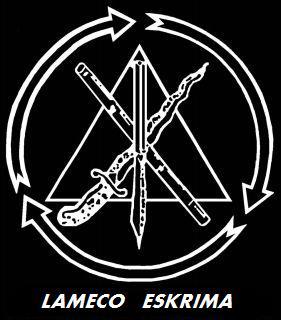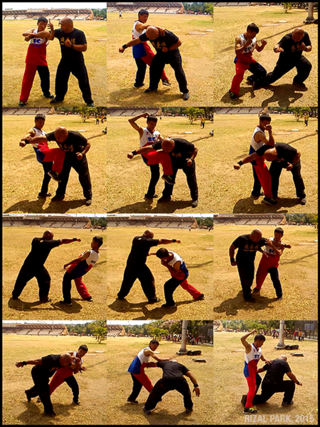
Jeet Kune Do is a hybrid martial art conceived and practiced by martial artist Bruce Lee. It was formed from Lee's experiences in unarmed fighting and self-defense—as well as eclectic, Zen Buddhist and Taoist philosophies—as a new school of martial arts thought.

Filipino martial arts (FMA) refer to ancient and newer modified fighting methods devised in the Philippines. It incorporates elements from both Western and Eastern Martial Arts; the most popular forms of which are known as Arnis, Eskrima, and Kali. The intrinsic need for self-preservation was the genesis of these systems. Throughout the ages, invaders and evolving local conflict imposed new dynamics for combat in the islands now making up the Philippines. The Filipino people developed battle skills as a direct result of an appreciation of their ever-changing circumstances. They learned, often, out of necessity on how to prioritize, allocate and use common resources in combative situations. Filipinos have been heavily influenced by a phenomenon of cultural and linguistic mixture. Some of the specific mechanisms responsible for cultural and martial change extended from phenomena such as war, political and social systems, technology, and trade and practicality.

Arnis, also known as kali or eskrima/escrima, is the national martial art of the Philippines. These three terms are, sometimes, interchangeable in referring to traditional martial arts of the Philippines, which emphasize weapon-based fighting with sticks, knives, bladed weapons, and various improvised weapons, as well as "open hand" techniques without weapons.
The following outline is provided as an overview of and topical guide to martial arts:
Doce Pares is a Filipino martial art and a form of Arnis, Kali and Eskrima, that focuses primarily on stick fighting, knife fighting and hand-to-hand combat but also covers grappling and other weapons as well. In reality, the stick is merely considered an extension of the hand, and is meant to represent almost any weapon, from sticks to swords to knives to anything else you can place in your hand and use as a weapon in the modern context. Doce Pares was founded in 1932.

Kombatan is a Filipino martial arts system. The founder of the system was GGM Ernesto Amador Presas. The current head of the system is Ernesto Presas Jr. The style is known for its double stick techniques, but it features other stick and blade techniques, as well as empty-hand methods.
Erwin Ballarta is the executive director of the Texas Police Association, a 501(c)(3) association founded in 1895 with the main purpose of promoting professionalism in law enforcement. Ballarta was previously the Executive Vice President of Capitol Strategic Operations He is a self-defense expert in Pekiti Tirsia Kali and various weapons. Ballarta has taught hand-to-hand combat and weapon tactics to the FBI, the Texas Highway patrol, and various military personnel and has been a bodyguard of George W. Bush and various celebrities. He was a Lieutenant with the Texas Department of Public Safety (DPS), where he was the Recruit School Coordinator and Defensive Tactics Coordinator for the Training Academy. He retired from the Texas D.P.S. at the end of August, 2008. He is also president of the Austin Filipino American Association and the executive director of the Texas Kali Association.

Edgar Sulite was a teacher of Filipino martial arts. He was the creator of Lameco Eskrima and trained such notables as Dan Inosanto, Ron Balicki, Larry Hartsell, Fred Degerberg, and Diana Lee Inosanto.

Lameco Eskrima is the system of Filipino martial arts founded by Edgar Sulite based on his training and experience with various Philippine Martial Arts masters, with heavy influence from Jose Caballero and Antonio Ilustrisimo.

Sibat is the Filipino word for spear, used as a weapon or tool by natives of the Philippines. The term is used in Tagalog and Kinaray-a. It also called bangkaw, sumbling or palupad in the islands of Visayas and Mindanao; and budjak among Muslim Filipinos in western Mindanao and the Sulu Archipelago.
Latigo y Daga is a Filipino martial art which focuses on the use of flexible weapons, particularly whips. It combines elements from a number of martial arts found in Malaysia, the Philippines, and Indonesia.
Ciriaco "Cacoy" Cañete was a Filipino martial artist of the Doce Pares Eskrima Club. He was the last surviving member of the club, which was founded in January 1932. He was also a 12th degree black belt. His version of the Doce Pares Eskrima system is known as Cacoy Doce Pares. In 1951 he developed a personal system of his named Eskrido.
A knife fight is a violent physical confrontation between two or more combatants in which one or more participants are armed with a knife. A knife fight is defined by the presence of a knife as a weapon and the violent intent of the combatants to kill or incapacitate each other; the participants may be completely untrained, self-taught, or trained in one or more formal or informal systems of knife fighting. Knife fights may involve the use of any type of knife, though certain knives, termed fighting knives, are purposely designed for such confrontations – the dagger being just one example.
Bob Breen is an author and professional martial artist who began martial arts training in 1966. He has trained under a significant number of senior martial arts experts and respected figures in the martial arts world. He has published 5 martial arts books.
Arnis in popular culture reflects the impact that the Filipino martial arts of arnis/eskrima/kali have made outside of the martial arts community. The three terms are roughly interchangeable and for the purpose of convenience, the term arnis will be used throughout the article. These arts emphasize weapon-based fighting with sticks, blades, improvised weapons and hand-to-hand fighting which is formally known as Mano Mano or Pangamut. Because of this training with live weapons, elements of arnis have made an impact in film, video games, television, and comic books. Arnis is often used to train actors and stuntmen how to handle similar weapons for use in movies.
Italian martial arts include all those unarmed and armed fighting arts popular in Italy between the Bronze age until the 19th century AD. It involved the usage of weapons. Each weapon is the product of a specific historical era. The swords used in Italian martial arts range from the Bronze daggers of the Nuragic times to the gladius of the Roman legionaries to swords which were developed during the renaissance, the baroque era and later. Short blades range from medieval daggers to the liccasapuni Sicilian duelling knife.

Suntukan is the fist-related striking component of Filipino martial arts. In the central Philippine island region of Visayas, it is known as Pangamot or Pakamot and Sumbagay. It is also known as Mano-mano and often referred to in Western martial arts circles of Inosanto lineage as Panantukan. Although it is also called Filipino Boxing, this article pertains to the Filipino martial art and should not be confused with the Western sport of boxing as practiced in the Philippines.
Leo Gaje is the grandson and heir to Conrado B. Tortal and the present Keeper of the Pekiti-Tirsia Kali System.
Wael Abdelgawad is an American-born novelist, web developer and martial artist, best known for founding one of the first online Muslim matchmaking services, and for his fictional portrayals of American Muslims. As a columnist for the multi-author blog MuslimMatters.org, he has published a series of online novels that have garnered popular attention from Muslim readers. His writings are often quoted on social media websites such as Tumblr, Facebook and Twitter.








